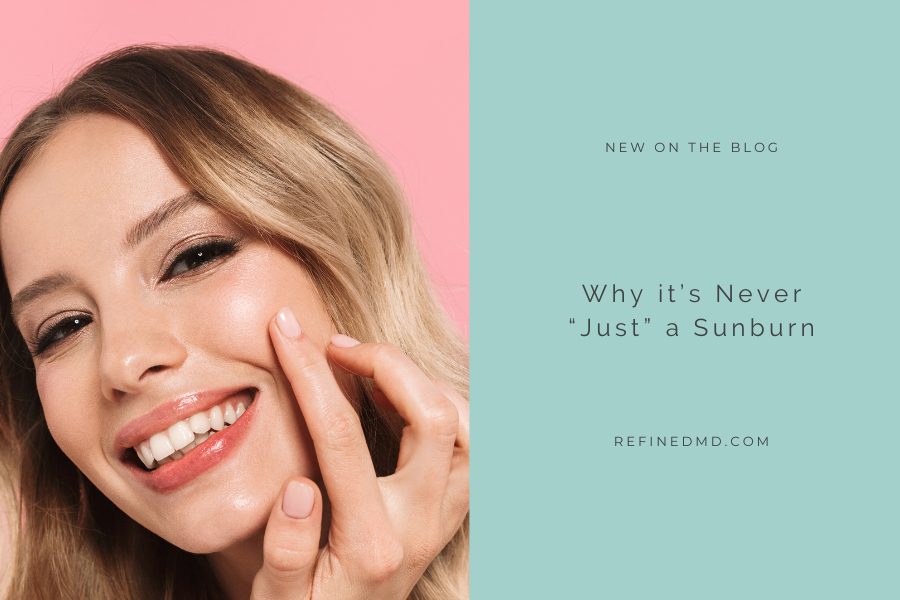
11 Apr Why it’s Never “Just” a Sunburn
A sunburn is your skin’s immediate response to excessive sun exposure, which can then be followed by an increase in melanin (a “tan”) to decrease damage in case of recurrent sun exposure in the near future. RefinedMD urges patients to avoid any UV damage, whether it’s a sunburn or a tan, by using high-quality skin care products only available at your dermatologist’s office. Fortunately, many Western countries have changed how tans are perceived in recent years thanks to education and the increase in skin cancer diagnoses. However, there’s still a lot of information that needs to be spread so that everyone understands the risk every sun exposure has on increasing the odds for skin cancer.
When someone has a history of sunburns, particularly if the sun damage occurred earlier in life, their odds of being diagnosed with skin cancer increases. Starting a sun protection regimen as early as possible is key to preventing skin cancer and other signs of sun damage. Sadly, even with all of the information on sun damage available today, the majority of high schoolers still report at least one sunburn per year. A survey by the National Youth Risk Behavior committee found that 63.9 percent of girls and 53.2 percent of boys in their senior year got at least one sunburn in the past year.
Understanding the Risks of Sunburns
The technical term for a sunburn is erythema, and it’s caused by severe or excessive exposure to the sun’s UV rays. A sunburn is an acute inflammatory response, and can be caused from indoor tanning, outdoor tanning, or even going about your daily tasks (like driving without wearing SPF sunscreen). Most people know the common and immediate symptoms of a sunburn: warm and red skin, tenderness, and edema that might lead to blisters. Every year, about 33,000 people visit the ER for a sunburn and this includes individuals of any race and ethnic group. Anyone can get a sunburn or skin cancer, although those with more melanin do have more natural protection.
If you have more “sun sensitivity” than the general population, you’re at an increased risk of developing skin cancer and particularly melanoma—the deadliest of all skin cancers. You’re considered sun sensitive if you tend to burn instead of tan. However, the severity of a sunburn also depends on how hydrated the skin is, the thickness of the exposed skin (the face is much more prone to burns than the limbs), and the UV wavelength and dose. Other factors include the time of day, altitude and latitude, and nearby reflective surfaces.
UV Radiation: Factors for a Sunburn
A sunburn occurs from a specific UV radiation dose and can include a high UV dose in a short amount of time or lower doses over extended periods of time. Of course, each person is unique in how their skin responds to various UV radiation doses. A person’s skin type in this regard can range from 1 – 6. Moderately pigmented skin requires up to five times the exposure amount to burn compared to lightly pigmented skin, whereas those with dark pigmentated skin can withstand up to 30 times the exposure compared to their fairer counterparts.
If you have skin type I, that means you have pale skin that always burns and never tans. Type II individuals also have white skin, always burns, but can achieve a minimal tan. Type III skin has light brown skin and can sometimes have a mild burn but achieves an average tan. Type IV has moderate brown skin, rarely burns, and tans with ease more so than average. Type V people have dark brown skin, rarely burn, and can tan much easier than average. Type VI has very deep pigmented skin and never burns.
How You Can Protect Yourself from Skin Cancer
Safeguarding yourself from skin cancer is a two-prong approach. First, it’s critical to adopt a good sun protection regimen right now—it’s never too late. This includes a quality, medical-grade SPF of at least 30 with broadband protection. It’s also just as important to liberally reapply this sunscreen every 75 minutes any time you’re exposed to UV light (including when you’re indoors working by a window). A yearly skin check is also a must for everyone, because the sooner skin cancer is caught, the easier it is to treat.
If you want more information on sun protection, including a customized sunscreen regimen, or you would like to schedule your annual skin check, trust a leading dermatologist to care for the biggest organ you have. Call RefinedMD today or complete the online contact form.
